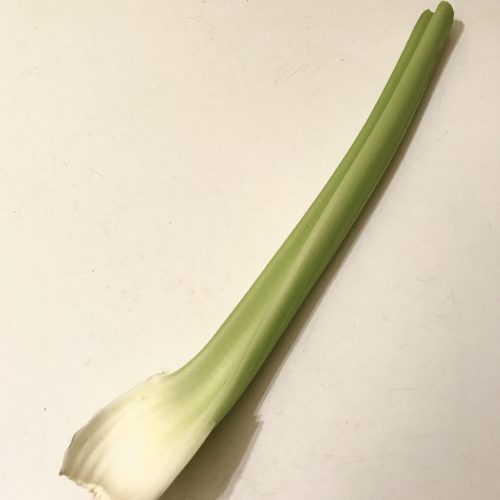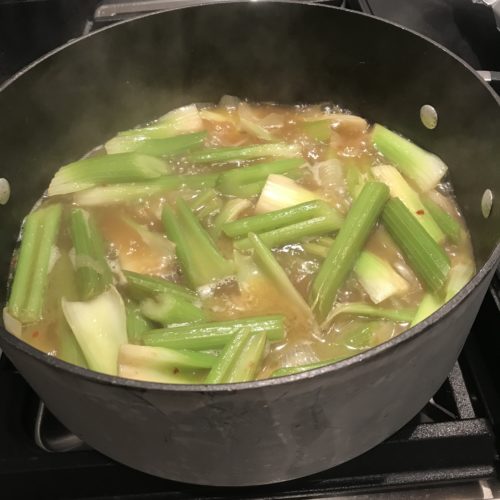
Do all uncooked foods talk back? Snap crackle crunch; that’s how cerealized infants learn words for eating. Yet the sound of celery is curbed by wilt. And then comes heat, and silence. Steady, serious warming hushes carrots, apples, globes.
In chicken noodle soup, celery logs sog after a simmer unless added optimistically toward the end. Who are the wasters who’d have us “flavor” our soup and discard the sodden stalks that Edward G. Robinson would give his life for in Soylent Green?
The same goes for stew, too. I’m a voyeur now, the boy whose reluctant seder mom stuffed yards of celery with some kind of white and cheesy reward, a holiday offering we had been instructed to enjoy. I’m not complaining, not at all, but, looking around the gray table, I don’t wish to be stuffed, smeared and dusted with tasteless paprika in my coffin.
“Ants on a log” — just discovered these are a tease of raisins skipping across peanut-butter stuffed celery — would be laughed off the Jewish board, even the log with real ants, served for a while as an amuse-bouche in a Manhattan Mexican destination.
When I asked friend Dan about his first raw celery, he made a face and said he never had that as a child and thought it disgusting. His Chinese mother offered only cooked celery, and I didn’t ask if it was the tender Asian variety or stolid supermarket bundle shipped from medieval Imperial Valley.
Uncooked? He looked as if he’d been asked to eat bloody chicken.
Raw celery can’t hide and even cooked retains a face — not the same as flavor — that won’t allow a mask. Dan has never had “Jewish champagne,” Dr. Brown’s Cel-Ray (made in Brooklyn, 1868, first as tonic), though he’s been to Katz’s Deli many times. Cel-Ray will disappear soon, for lack of memories of memories.
It soothes, and Diet Cel-Ray, which this baby diabetic needed, was removed from the market for lack of sales. So yesterday I fashioned my own. You vant a recipe, I’ll give you a recipe:
Cup water, less than a cup of sugar, a few tablespoons gnat celery seeds, some celery and leaves chopped fine, black pepper, shakes of salt, a squeeze of lemon juice or scrape of zest. Heat to simmer, stir, a few minutes. Let sit a while as you sit, strain, put ochre syrup in fridge, mix with seltzer in proportions till you find yours.
A recipe of a different kind was touted by an eater I trust, one that appeared in a just-published cookbook, Jubilee: Recipes From Two Centuries of African American Cooking by Toni Tipton-Martin. I’d taken on a Thanksgiving task, and her braised celery could be my centerpiece, alongside spiced nuts and another purloined recipe, for cranberry-apple sauce with lime, not orange, and chipotle, to better match the boughten-in-Brooklyn smoked turkey.
When I hefted in three fat pounds of pecans, cashews, walnuts (roasted in butter, rosemary, salt, brown sugar, cayenne), my supposed friends, fewer than a dozen, laughed at me out loud for more than a minute: “Think we could actually make a dent in that?”
You’ve seen how a secretly wet finger mines an empty bowl’s bottom treasure? With too many nuts, took less than an hour.
Braised celery happens when opposites marry: rigid, noisy, one-note vegetable, and limpid, choral broth. Chef Edna Lewis liked the way a beef bath countered the celery. Tipton-Martin used a method published in 1912 by chef S. Thomas Bivens, a chicken-broth version tipped up in richness so slightly with his beurre manié flourish.
I served this twice, first the chicken. Celery doesn’t melt, because it’s not a green icicle, but its dental-floss ribs (called collenchyma), if not stripped first, bow into edible. The sly broth, sometimes made more seductive with target celery already in it, ingratiates itself during the slow boil and arrives at the end almost dominant.

Braised Celery: Clean three bunches of celery and chop stalks (on bias) into two- or three-inch pieces, leaving leaves for soup. In big pot or Dutch oven, heat drippings from whatever roast you might have, or bacon fat, or butter, olive oil. At medium-high heat, sauté a couple of coarsely chopped onions until they begin to melt but don't brown. Stir in celery well, add black pepper and red pepper flakes. When celery starts to give up water, add a few smashed cloves of garlic, stir, wait a minute or two and pour meat, chicken, vegetable stock or miso broth, even water, until vegetables are just covered. Bring to boil and then simmer, uncovered, until celery loses its spine, 30 minutes to an hour, stirring occasionally. Add a thumb-size nubbin of beurre manié (knead a tablespoon or two of soft butter with equal amount of flour) and mix in energetically over heat until broth slightly blooms. Add a bit of cream, stir, taste, salt if necessary.
The reduced result is luxurious, but puzzling, the sighing remains of a heated battle. Words to describe thoroughly and properly cooked dishes rarely obtain from their elements.
The second time, in a red miso mix, the celery rises higher, though still on its knees.
Celery, certain, bullies others. Makes peace, ameliorates. Stands arrogant. Will rarely be accepted by neighbors. May never be allowed to speak quietly, alone.
